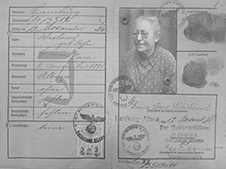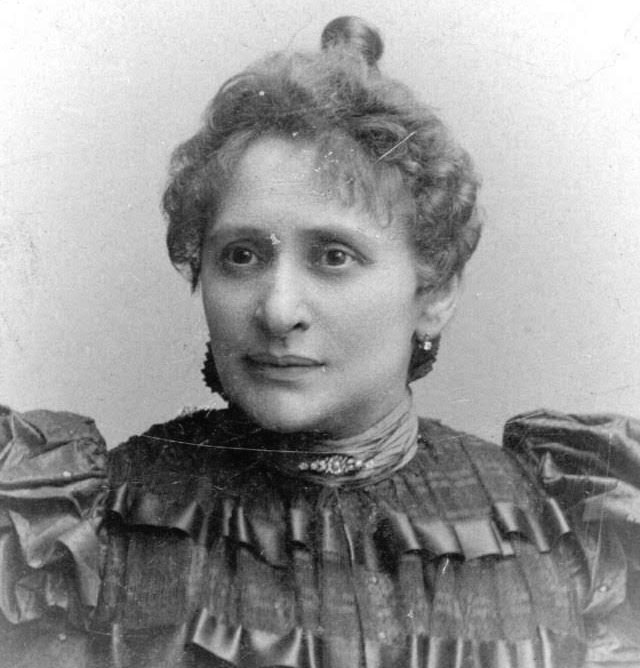Search for Names, Places and Biographies
Already layed Stumbling Stones
Suche
Emma Weiland (née Cohn) * 1871
Schäferkampsallee 29 (Eimsbüttel, Eimsbüttel)
HIER WOHNTE
EMMA WEILAND
GEB. COHN
JG. 1871
DEPORTIERT 1943
THERESIENSTADT
BEFREIT
further stumbling stones in Schäferkampsallee 29:
Dr. Rudolf Borgzinner, Martha Dessen, Heinrich Harth, Meyer Jelinewski, Margaretha Magnus, Eva Emma Mathiason, Gertrud Stillschweig, Clara Streim
Emma Weiland, née Cohn, born on 8 Nov. 1871 in Altona, deported to Theresienstadt on 19 Jan. 1944, liberated on 8 May 1945, died on 27 Nov. 1945 in Hamburg-Eimsbüttel.
Schäferkampsallee 29
Emma Weiland, called Emilie, was born the daughter of Isaac Cohn and his wife Fanny Möller. Both parents were natives of Altona. At the time of their wedding in 1868, 2,359 Jews were listed there.
Emma’s father Isaac came from an Altona merchant family that can be traced back two generations. He himself was a "produce trader” ("Productenhändler”), so presumably, he bought agricultural products from farmers and sold them in his shop. Isaac and his wife Fanny, 13 years his junior, were buried at the Altona Jewish Cemetery on Bornkampsweg, where many relatives are also buried.
Emma’s mother Fanny had eight siblings. Her daughter Emma accordingly enjoyed a large number of aunts, uncles, cousins, and cousins. Fanny’s ancestors came from Northern Germany. Her paternal great-grandfather – Jesaias Möller – was a native of the Jewish settlement in Fackenbourg near Lübeck. In the list of Jews living in Altona in 1860, his profession is listed as exterminator. Fanny’s mother Mariane Hirsch came from Kiel. Not much is known about her.
There are two known addresses of Emma’s family in Altona-Altstadt: Breitestraße 145 and Langestraße 84 in 1878. Emma was the second child of the family.
Her eldest brother Josef (also spelled Joseph, called John) was born in 1870. Her younger brother Max was born in 1872, followed by Rudolf in 1878 (see www.stolpersteine-hamburg.de for Josef and Max). The brothers were circumcised. It can be assumed that they were raised religiously, as was usual at the time. According to the Cohn family, Emma was a "very lovable woman”.
On March 21, 1896, at the age of 24, Emma married her husband August Hermann Weiland. August, who was baptized a Protestant, came from Graefentonna, district of Gotha (Saxony-Coburg) and was 31 years old at the time. August was born an illegitimate child. His mother Friederike Henriette Kettenbeil, divorced Möller, married her second husband Christian Gottlieb Weiland when August was almost two years old. When August was 14, Christian professed paternity. August trained as a roofer. In later documents he was referred to as "worker" and "trader".
Emma’s siblings Josef and Rudolf also married non-Jewish spouses. This was the first time in her generation that membership of the Jewish Community was relaxed. In Hamburg, Jewish women lost their community affiliation when entering an interdenominational marriage.
Soon after the wedding, Emma Weiland became pregnant and in 1897, she gave birth to her daughter Paula, who died only one year later. At that time, the family lived on the fourth floor of Gustavstraße 113 (today Gilbertstraße). In 1899, their son Hermann was born. By then, the family lived on the ground floor of Conradstraße 24 (today Gilbertstraße). Later, they moved to Kieler Straße 18 in Hamburg Langenfelde and built up a pig-fattening farm there. In 1910, daughter Margret ("Grete”) was born. Hermann and Grete Weiland were baptized Protestants at the Eimsbüttel Apostle Church.
In 1911, August Weiland, who had fallen ill, died at the age of 46. 39-year-old Emma had to support her two children on her own and continued to run the pig farm in her own name. Margret reported that they lived in extreme poverty. The siblings often had to work in the stable. The very goal-oriented Margret was not able to get the high school diploma she wanted. She looked back on her childhood with much sadness.
In 1914, the First World War began. Hermann Weiland served in the army from 1917 to 1919, where he was awarded an Iron Cross Second Class. Afterward, he moved back in with his mother and supported her in the company.
The address of the pig farm is given in the directories from 1929 to 1933 as being Kieler Straße 203/207. Hermann Weiland mentioned in his curriculum vitae that they had to close the farm at the turn of the year 1933/1934 due to "time-related circumstances,” presumably, the Nazis’ assumption of power.
At that time Margret married her husband Jonni Nielsen and moved with him to Thusneldastraße 6 in Hamburg-Stellingen, where they lived until 1994.
From then on, Hermann Weiland made a living for himself and his mother as a coachman for the Bernhard Jasper haulage company, but he continued to live with Emma Weiland. On 9 Nov. 1938, he was arrested and committed to the Sachsenhausen concentration camp. He remained there until 2 Dec. 1938, and after his return, he resumed his work as a coachman until his employer was drafted into the army in 1940. He did not find a new job as a coachman, but worked as a farmhand for an acquaintance in Schnelsen. Thus, he eked out a living for himself and his mother.
On 25 Jan. 1941, Emma was forced to bear the additional first name of "Sara,” as is recorded in her Jewish identity card ("Judenpass”) and also in the register of the Hochdeutsche Israelitengemeinde ("High German Israelite Community”) (according to Nazi regulations, she should have complied with this starting in Jan. 1939).
On August 27, 1942, after many years without children, Margret gave birth to her son Kai Nielsen. Emma became a grandmother.
In September 1942, Emma's brother Max was killed in Treblinka, of which she probably did not learn anything during her lifetime.
On 24 July 1943, bombs fell on Hamburg during "Operation Gomorrah,” destroying large parts of the city. Emma’s entire house also burned to the ground. She and Hermann were left only with the clothes they wore on their backs. She then moved to a Jewish retirement home, possibly to the Jewish retirement home at Sedanstraße 23. In the same year, at the age of 71, she went blind and moved to the Hamburg Israelite Hospital, which was then (again) housed at Schäferkampsallee 29.
In Dec. 1943, Heinrich Müller, head of the Gestapo, gave the order that Jewish spouses from "mixed marriages” ("Mischehen") that had ended in death or divorce should henceforth be deported as well. In January, a wave of deportations to Theresienstadt began throughout the Reich. On 10 Jan. 1944, Emma Weiland was arrested. Four days later, all of her assets were confiscated. On 19 January, she was deported on transport number VI/9 together with 61 other persons. On 22 January, they reached Theresienstadt. On 21 April, their son received a postcard: "Dear children, soon we will reach our destination, I am well, and I send my best to all of you (?) Many greetings, your mother.” The postmark on the card was 22 January from Prague.
In Theresienstadt, Emma Weiland lived in the home for the blind, Building D V, Block Q 319 (later Badhausgasse 19). Each person there had an average of 3.2 square meters (about 34.5 sq ft) of space at his or her disposal.
The year 1944 saw an inspection visit by the International Committee of the Red Cross in the ghetto as well as production of the film entitled Theresienstadt. Ein Dokumentarfilm aus dem jüdischen Siedlungsgebiet ("Theresienstadt. A documentary film from the Jewish settlement area”). Thousands of Jewish residents were further deported to Auschwitz and murdered in the course of these propagandistic actions. Emma Weiland was not among them; she survived.
In the late evening of 8 May 1945, the Red Army liberated the ghetto. Due to a typhus epidemic, however, the liberated persons could not return home immediately. Emma Weiland remained in quarantine until mid-June. On 14 June, she received medical confirmation that she had not been diagnosed with typhus. However, she was to take medication at home as a precaution. She left on 27 June and arrived in Hamburg three days later.
She was then registered as residing with her daughter Margret (Grete) and her husband Jonni Nielsen at Thusneldastraße 6 in Hamburg-Stellingen. In her application to the Restitution Office (Amt für Wiedergutmachung) in Sept. 1945, she wrote that she had returned from Theresienstadt with severe physical injuries. According to family tradition, she was able to see again when she returned.
She passed away on 27 Oct. 1945 at the age of 74 in the Israelite Hospital on Schäferkampsallee. According to the death certificate, she died of agranulocytosis, the absence of granulocytes in the blood. This disease reduces the ability to fight off infections. It can be caused by malnutrition.
Emma Weiland was buried in the Stellingen Cemetery in Row Grave II Section D N-336. The grave no longer exists today.
Emma Weiland today has offspring in the fifth generation.
Emma Weiland’s uncle, Marcus Ruben Cohn, was also a merchant. His son Leopold Cohn (see www.stolpersteine-hamburg.de) – her cousin – established a successful wholesale business in grain and animal feed, achieved considerable economic and social success, and became a member of the Board of Directors of the Grain Exchange. In Nov. 1938, his company was forced into liquidation. He and his wife Gertrud were deported to Riga-Jungfernhof on 6 Dec. 1941, where they were murdered. The Hamburg Chamber of Commerce commemorates him with a Stolperstein at Adolphsplatz 1. His descendants now live in New York.
Translator: Erwin Fink/Changes Katrin Holtsteger August 2023
Kindly supported by the Hermann Reemtsma Stiftung, Hamburg.
Stand: September 2020
© Katrin Holtsteger
Quellen: Dokumente aus dem Privatbesitz der Familie; StaH, Amt f. Wiedergutmachung, 351-11_1831; 351-11_1833; Jüdische Gemeinden, 522-1/ Hochdeutschen Israelitengemeinde in Altona: Verzeichnis der israelitischen Einwohner in Altona mit Index (1860), 158, S. 8. Geburts-, Heirats- und Sterberegister 1866 – 1874, 222 c, S. 40; Geburtenregister 224 a; https://www.ancestry.de/ div.; https://collections.arolsen-archives.org/archive/5128303/?p=1&s=weiland,emma&doc_id=5128303;http://www.dasjuedischehamburg.de; https://www.hk24.de/share/flipping-book/4188630/index.html#page/12; http://hup.sub.uni-hamburg.de/volltexte/2008/25/pdf/HamburgUP_HHF03_Lange.pdf; https://www.ik-h.de/ueber-uns/geschichte; https://www.israeliten-luebeck.de/de/juden-von-fackenburg/; https://juedische-geschichte-online.net/thema/familie-und-alltag; http://www.jüdischer-friedhof-altona.de/datenbank.html; https://www.statistik-des-holocaust.de.



